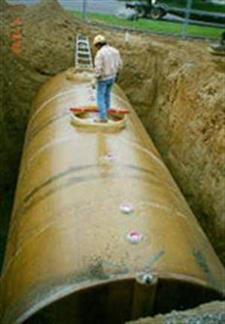The Underground Storage Tank (UST) inspection program ensures that hazardous materials stored in underground tanks are not released into the environment, potentially polluting ground and surface waters. 
The Orange County Health Care Agency (OCHCA), Environmental Health Division oversees the UST inspection program in most of the cities of Orange County, with the exception of Anaheim and Orange. As the Certified Unified Program Agency (CUPA), Environmental Health is tasked by the Secretary for Environmental Protection to implement and enforce the underground storage tank codes. Specialists from Environmental Health inspect underground storage tanks, monitoring equipment, and compliance documents of UST systems to ensure that these systems are in compliance with the applicable laws and regulations.
This Agency also serves to educate and assist tank owners and operators with regulatory requirements. To contact your inspector directly, please use UST Inspector Phone List- by city. For general questions please call 714-433-6000 and request to speak to the Duty Officer.
UST Plan Check Update
There are currently four ways to submit plans: by appointment, drop-off, email, and mail. Plans will not be processed until the payment has been received (refer to Fees). When submitting a Plan Check, please include a Facility Modification Application (FMA) and four copies of the plans. Electronic Plan Checks and all inquiries should be submitted to USTnotifications@ochca.com.
UST Testing Notification & Test Results:
To notify this Agency of an upcoming Monitoring System Certification, Spill Container Test, Secondary Containment (SB989) Test, or Overfill Prevention Equipment Inspection, please submit your request by email to USTnotifications@ochca.com at least 48 hours prior to the test.
Current Underground Storage Tank Forms Required:
Monitoring System Certification Form
Spill Container Test Report Form
Secondary Containment Testing Report
Overfill Prevention Equipment Inspection Report Form
Test results are due within 30 days and may be submitted directly to the UST Notifications inbox. Paper copies may be mailed to:
Orange County Environmental Health
PO Box 25400
Santa Ana, CA 92799
Informational Documents from the State Water Resources Control Board:
Overfill Prevention Equipment Inspection Requirements
Spill Container Testing Requirements
Secondary Containment Testing Requirements
New Construction, Upgrade, and Compatibility Requirements
Emergency Generator Tank System Line Leak Detector Requirements
Attention Secondary Containment Testers:
The secondary containment test procedure described in the 2002 document “Standard for Secondary Containment Testing of Underground Storage Tank Systems” has been rescinded by the CalCUPA Forum. The procedure is no longer valid. In accordance with 23CCR section 2637 testers must follow manufacturer’s guidelines or industry standards, such as the PEI 1200 manual. OCHCA will no longer accept test results that utilize the rescinded procedure for sites.
UST Forms:
Businesses are required to submit all required UST compliance documents to the California Environmental Reporting System (CERS). To access the Business Portal, please visit https://cers.calepa.ca.gov/.
Underground Storage Tank System Testing Intervals
| Monitor System Certification | X | | X | |
| Spill Container | X | | X | |
| Overfill | | X | X | |
| SB989 Secondary Containment1 | | X | X | |
| Tank Integrity | | | | X2 |
| Pipeline Integrity | X3 | | | |
1Not required on VPH systems.
2Only required for single-walled tanks. Interval depends on monitoring plan.
3For single-walled piping or systems not programmed for positive shutdown and fail safe.
UST Modifications & Repairs:
Please refer to our Guidelines for UST Modifications document to determine if the scope of work you intend to perform will require the submittal of a “plan check” and payment of fees to this Agency. Please visit the following link to access the current fee schedule: Hazardous Materials Management Program Fee Schedule.
View this video for a simplified look at the UST "plan check" process.
A resource for small and medium-sized businesses in Orange County
This manual is intended to provide businesses with the tools necessary to own and operate an underground storage tank system in compliance with the rules and regulations enforced by OCHCA.